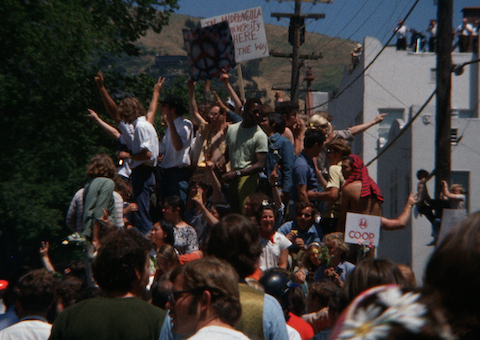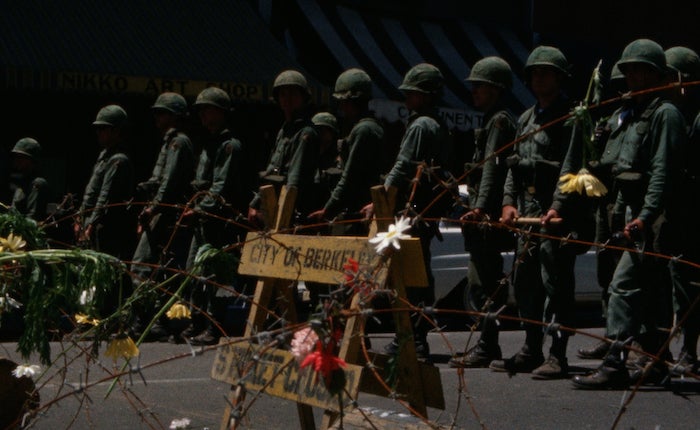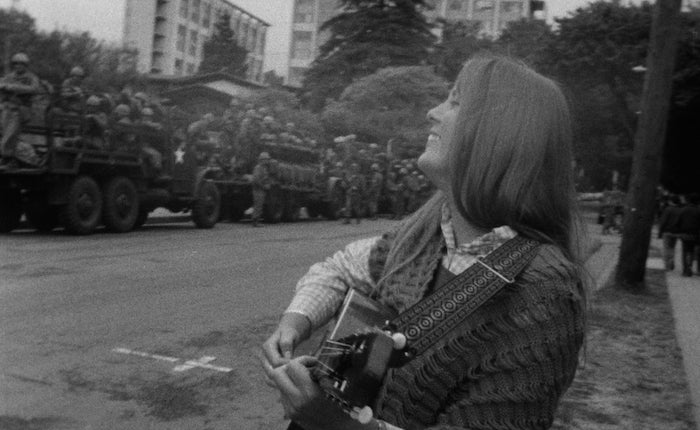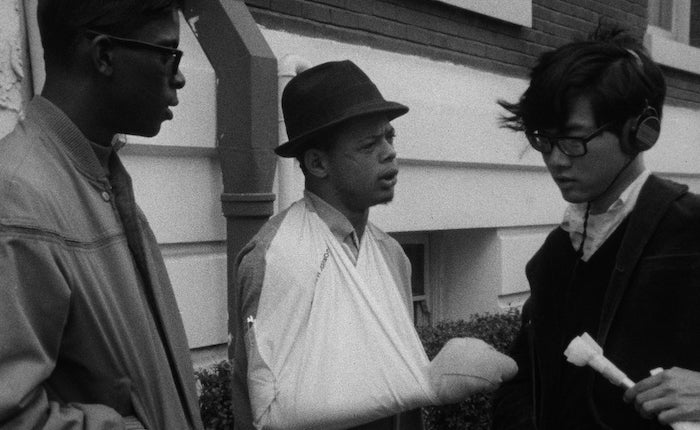
Second Campaign (1970)
Our guest writer is Christina Scholze, a second year UCLA student in the Master of Library and Information Science degree program with a specialization in Media Archival Studies. Scholze worked under the supervision of UCLA Film & Television Archive staff to inspect, prepare, digitally restore and preserve the film Second Campaign. This internship was made possible by generous funding from the Myra Reinhard Family Foundation.
The student experience across the U.S. throughout the late 1960s and early 1970s was deeply embedded in the larger issues concerning the country — notably the anti-war movement, the fight for civil rights, women’s liberation and concerns over free speech. These topics were at the forefront of the University of California campuses, especially at UC Berkeley where the Free Speech Movement began in 1964. With the university becoming known for its political activism, then-Governor Ronald Reagan gave a speech in 1966 criticizing the “small minority of beatniks, radicals and filthy speech advocates that have brought shame on a great university.”

Tensions came to a head in May 1969 over an undeveloped piece of UC property next to the Berkeley campus that had been transformed into a local park, known as People’s Park. After construction of the park began, the university announced plans to build a soccer field and proceeded to fence off and demolish the park. On May 15, an ongoing political rally moved off campus towards People’s Park, which in its occupation by police had come to represent growing free speech issues. In defending People’s Park, the crowd grew by several thousand and attempted to tear down the barricading fence. Violence ensued when officers used extreme force, resulting in several hundred injuries and one death, prompting Reagan to declare a State of Emergency and call on 2,000 National Guard members to secure the area. Amidst this conflict, UCLA film students Norman Yonemoto (1946–2014) and Nikolai Ursin (1942–1990) traveled to Berkeley to film the continuing protests, resulting in their documentary titled Second Campaign.
In a 2011 interview with the Japanese American National Museum, Yonemoto recalled how “everybody thought there might be another riot ’cause it was very volatile.” What Yonemoto and Ursin found was something unexpected — moments of communal joy. The film begins on a humorous note and continues with more serious scenes shot in black and white, showcasing expected political action. They filmed speeches and rallying cries, tense and more casual interactions with the National Guard, interviews with community members, and debates between protesters and police. There are compelling scenes of a folk singer performing for a National Guard audience, revealing peaceful aspects of the protest.

Towards the climax of the documentary, the tone shifts thematically and visually. Scenes bursting with color highlight triumphal moments of community-building. In his interview, Yonemoto emphasized the emotions of witnessing these moments develop when “cooler heads prevailed and it turned into a celebration of nothing in particular, just a celebration, a party.” Yonemonto continued, “at the time we made [the film] there was a nostalgia for the present,” perhaps referring to the tumultuous 1960s and the experiences of the younger generation. The film might reflect the desire to hold onto joyful moments amongst the turbulence. This nostalgia is reflected in the song complementing the second half of the film, where Bob Dylan sings, “Ah, but I was so much older then, I'm younger than that now.” Moments of happiness can still be found and held onto.
Second Campaign is a very specific historical artifact through the moments it captures and what it represents. On the surface the film sets out to detail political unrest of the People’s Park protest. But in taking a closer look, it captures an incredibly intimate view of celebration developing, not focusing on one particular ideology but on the emotional aspects of the events, in turn hoping for an emotional reaction from the audience. Its unique perspective moves beyond polarizing differences and as Yonemoto says, “its political purpose sort of melts away” as you get deeper into the film, “and you're presented with a directly emotional and psychological viewpoint.”

Yonemoto and Ursin themselves make appearances in the documentary. Yonemoto (pictured above, right) is filmed interviewing bystanders, and we can hear the filmmakers’ voices identifying themselves and answering questions. Their presence on camera adds to the student perspective of this historical event — not only as filmmakers, but as students visiting from another UC campus. Norman Yonemoto (sound/editing), a prominent and innovative visual artist, grew up in the Bay Area and attended the UCLA Department of Theater Arts, now the UCLA School of Theater, Film and Television, as an undergraduate, receiving his M.F.A. from the American Film Institute in 1972. Nikolai Ursin (camera), who worked under the name Nick Elliot later in his filmmaking career, attended UC Berkeley as an undergraduate and received his M.F.A. from UCLA in 1971. Another one of Ursin’s student films, Behind Every Good Man (1967), was restored by the UCLA Film & Television Archive and inducted into the Library of Congress’ National Film Registry in 2022.
As a UCLA student working on a UCLA student film, the restoration of Second Campaign was challenging but extremely rewarding. The elements deposited by Norman Yonemoto’s partner John Campbell — 16mm A/B rolls and the negative of the final scene — were inspected and prepared for digital restoration. It was very important to study notes left by the filmmakers on specific color choices to ensure the digital restoration matched Yonemoto and Ursin’s intentions. The 4K scans were digitally cleaned using DRS MTI, followed by editing and color grading. The editing work was incredibly complex and it was an interesting puzzle to solve and ultimately bring together. After spending a lot of time with this film, an important discovery I made was that the film’s title references the 1965 Watts Rebellion, which also involved the National Guard, adding even more layers to the meaning of their film. Second Campaign is a complex and emotional film that addresses important topics. It was interesting to delve into the mindset of the filmmakers, both literally in the construction of the film and also thematically in what they were trying to achieve with their documentary.
Watch Second Campaign online:
< Back to the Archive Blog






 Mobile Navigation
Mobile Navigation

